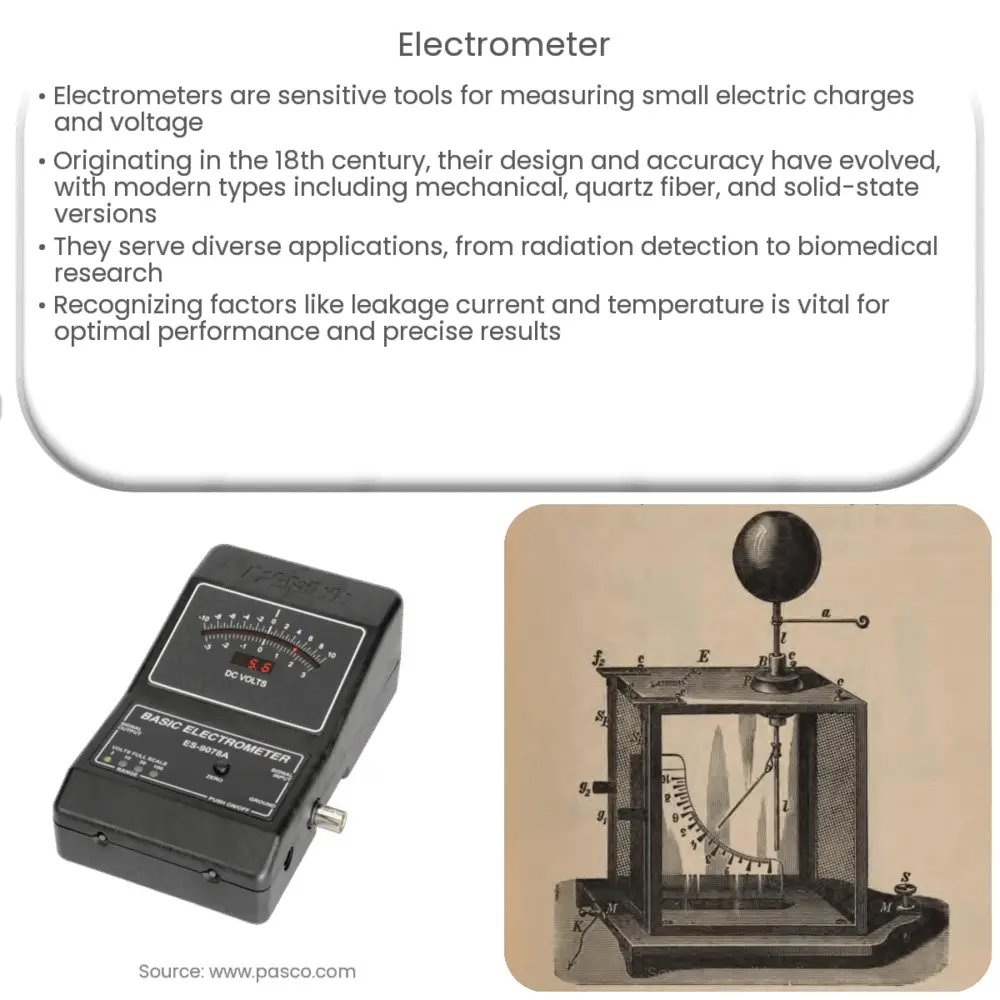Electrometers are precision instruments for measuring electric charges and voltages, used in diverse fields like radiation detection and semiconductor analysis.

Electrometers: Precision Instruments for Measuring Electric Charge
Introduction
Electrometers are highly sensitive instruments used for measuring small electric charges and voltage. Their primary function is to detect the presence of charge, and measure the amount of charge or potential difference between two points. Electrometers play a crucial role in various scientific and industrial applications, including electrostatic measurements, radiation detection, and semiconductor characterization. This article will delve into the history, design, types, and applications of electrometers.
History of Electrometers
The history of electrometers dates back to the 18th century, with the invention of the first electrometer by French scientist Jean-Antoine Nollet in 1748. Initially, electrometers were simple devices that used the principle of electrostatic repulsion to measure charge. Over the years, the sensitivity and precision of electrometers have vastly improved, with the introduction of vacuum tubes, quartz fiber electrometers, and solid-state electrometers.
Design and Principle of Operation
An electrometer is designed to measure electric charge or potential difference with minimal disturbance to the system under test. The device typically consists of an input terminal for the charge to be measured, a sensitive electrometer amplifier, and an output for displaying the results. The heart of an electrometer is the electrometer amplifier, which is responsible for converting the input charge or voltage to a measurable output signal.
The basic principle of operation for an electrometer is the use of electrostatic force or capacitance to detect the presence of an electric charge. In a traditional quadrant electrometer, a charged object is brought near a metal plate, causing the plate to move due to electrostatic force. The movement of the plate is then detected and measured to determine the charge. Modern electrometers, however, utilize electronic amplifiers and feedback systems to minimize the disturbance of the system being measured and improve accuracy.
Types of Electrometers
Electrometers can be broadly classified into three categories:
- Mechanical electrometers: These are the earliest type of electrometers, which rely on mechanical movements to detect and measure electric charges. Examples include the gold-leaf electroscope and the quadrant electrometer.
- Quartz fiber electrometers: Quartz fiber electrometers use a quartz fiber suspended between two electrodes to measure charge. The fiber moves in response to the electrostatic force, and the movement is detected by an optical system.
- Solid-state electrometers: Solid-state electrometers are the most modern and widely used type of electrometer. They employ electronic circuits, such as field-effect transistors (FETs), to measure charge or voltage. These devices offer high sensitivity, stability, and accuracy.
Applications of Electrometers
Electrometers have a wide range of applications in various fields, including:
- Electrostatic Measurements: Electrometers are used to measure electrostatic potential and charge distribution in insulators and conductors. They can also be used to measure the charge-to-mass ratio of charged particles, such as ions and electrons.
- Radiation Detection: In combination with ionization chambers, electrometers can detect and measure ionizing radiation, such as alpha, beta, and gamma rays. This is particularly useful in nuclear research, radiography, and radiation protection.
- Semiconductor Characterization: Electrometers can be used to measure the electrical properties of semiconductor materials, such as resistivity, carrier concentration, and mobility. They are also utilized for testing and characterizing semiconductor devices like diodes, transistors, and integrated circuits.
- Biomedical Research: Electrometers are employed in biomedical research for measuring electrical potentials in biological tissues, such as nerve and muscle cells, as well as studying the electrical activity of the heart (electrocardiography) and brain (electroencephalography).
- Environmental Monitoring: Electrometers can be used to measure atmospheric electric fields and detect atmospheric pollutants, such as aerosols and trace gases, by analyzing their electrical properties.
Factors Affecting Electrometer Performance
Various factors can impact the performance of an electrometer, including:
- Leakage current: The flow of current through the input impedance of the electrometer can cause errors in measurements. High-quality electrometers minimize leakage current to ensure accurate results.
- Temperature: Temperature fluctuations can affect the performance of electrometer components, leading to changes in sensitivity and accuracy. It is essential to maintain a stable operating temperature for optimal performance.
- External noise: Electromagnetic interference (EMI) and radio frequency interference (RFI) can introduce noise into the electrometer’s measurements. Proper shielding and grounding can help mitigate these effects.
- Input capacitance: The capacitance between the input terminal and the electrometer amplifier can cause errors, particularly when measuring small charges. Reducing input capacitance is essential for obtaining accurate measurements.
Conclusion
Electrometers are indispensable tools in various scientific and industrial applications due to their high sensitivity and precision in measuring electric charge and voltage. Advances in electrometer technology, particularly the development of solid-state electrometers, have significantly improved their performance and expanded their application range. Understanding the design, operation, types, and factors affecting electrometer performance is crucial for selecting the right instrument and obtaining accurate measurements in various fields.

